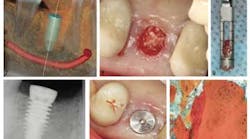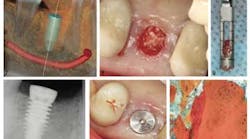Barrier aids bone regrowth after socket grafting
The hole left by a pulled tooth is more than just a place where food can get caught and the tongue can “worry” the gap. It is also a place where disease can weaken bone. Surgeons typically fill this hole with socket grafting material, but a barrier placed over the graft may help the bone regrow even faster.
ADDITIONAL READING |Does your dental extraction socket need a bone graft: A decision matrix
A study in the current issue of the Journal of Oral Implantology looks at a new type of barrier membrane, known as porcine collagen that has been recently introduced in the United States. The intent was to find out how quickly a bone graft can develop when porcine collagen is placed over the grafted tooth socket.
Read the abstract.
Socket grafting is one of the most frequently performed procedures in oral surgery. After a tooth is pulled, the tooth socket in the jawbone where the tooth had been anchored can rapidly shrink and make it impossible to place a dental implant. To prevent this, the surgeon fills the hole with a bone grafting material that combines with the natural bone to rebuild or preserve the bone’s strength. A barrier membrane, such as porcine collagen, can keep the gum from growing into the space.

